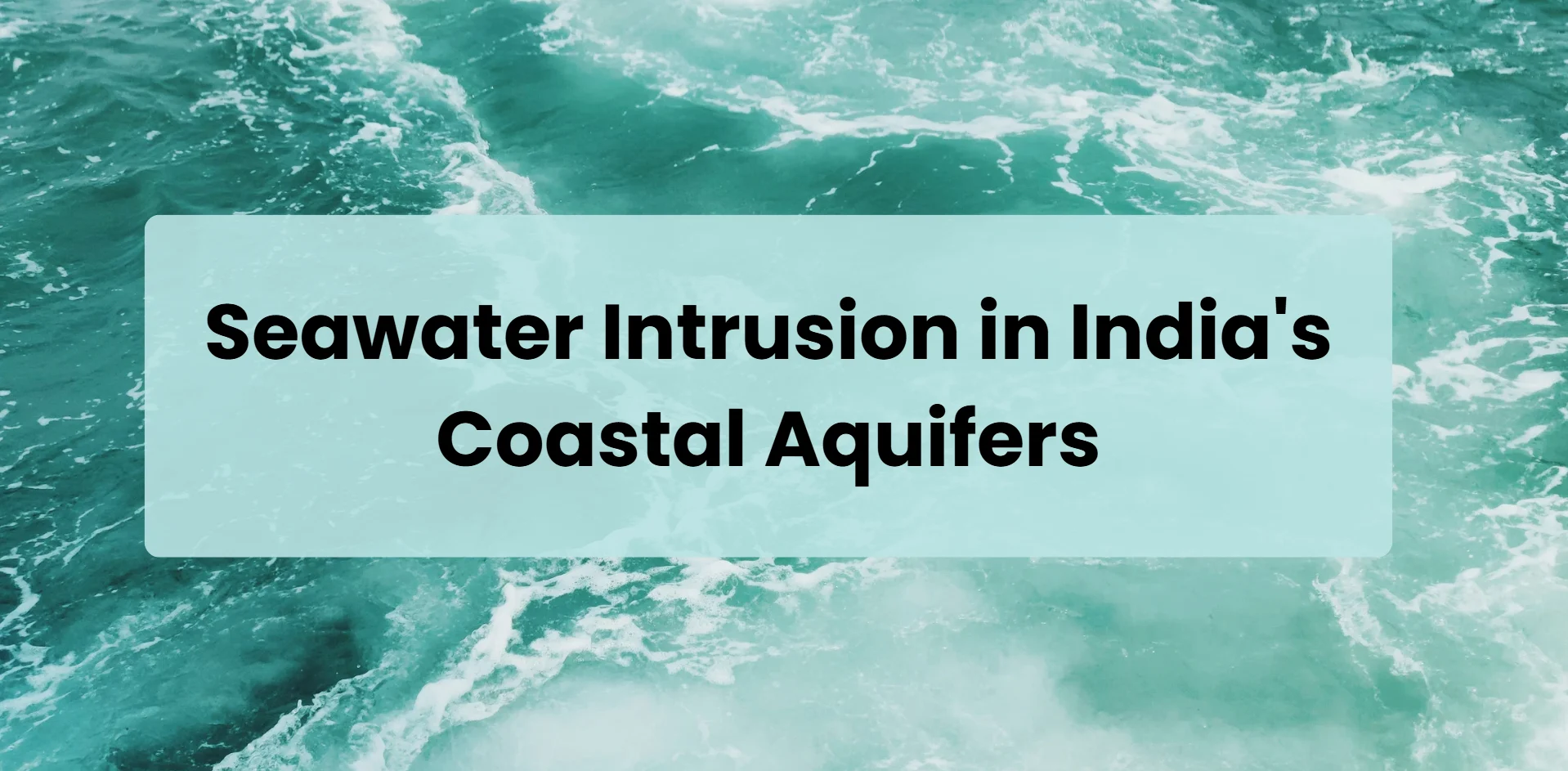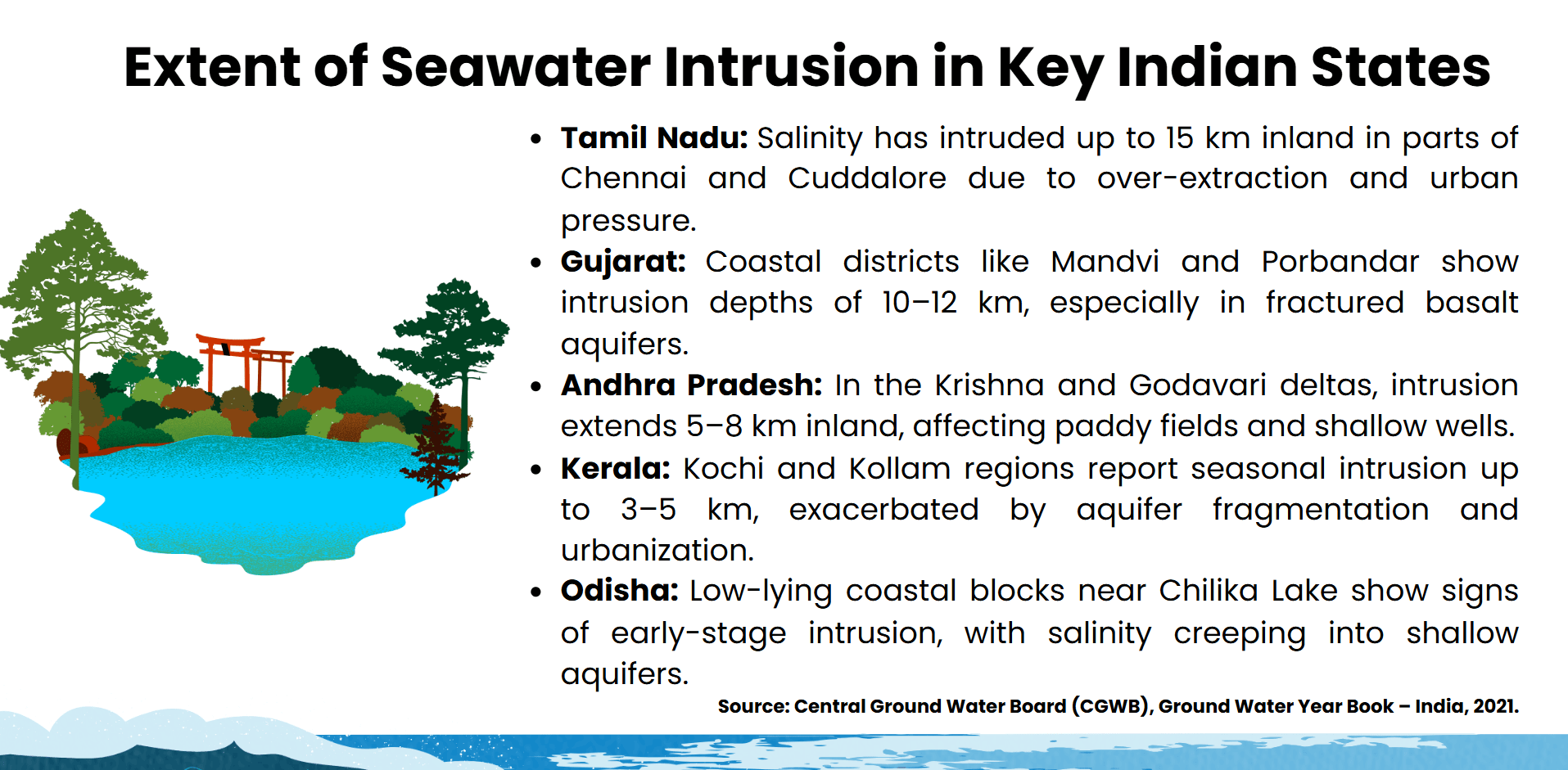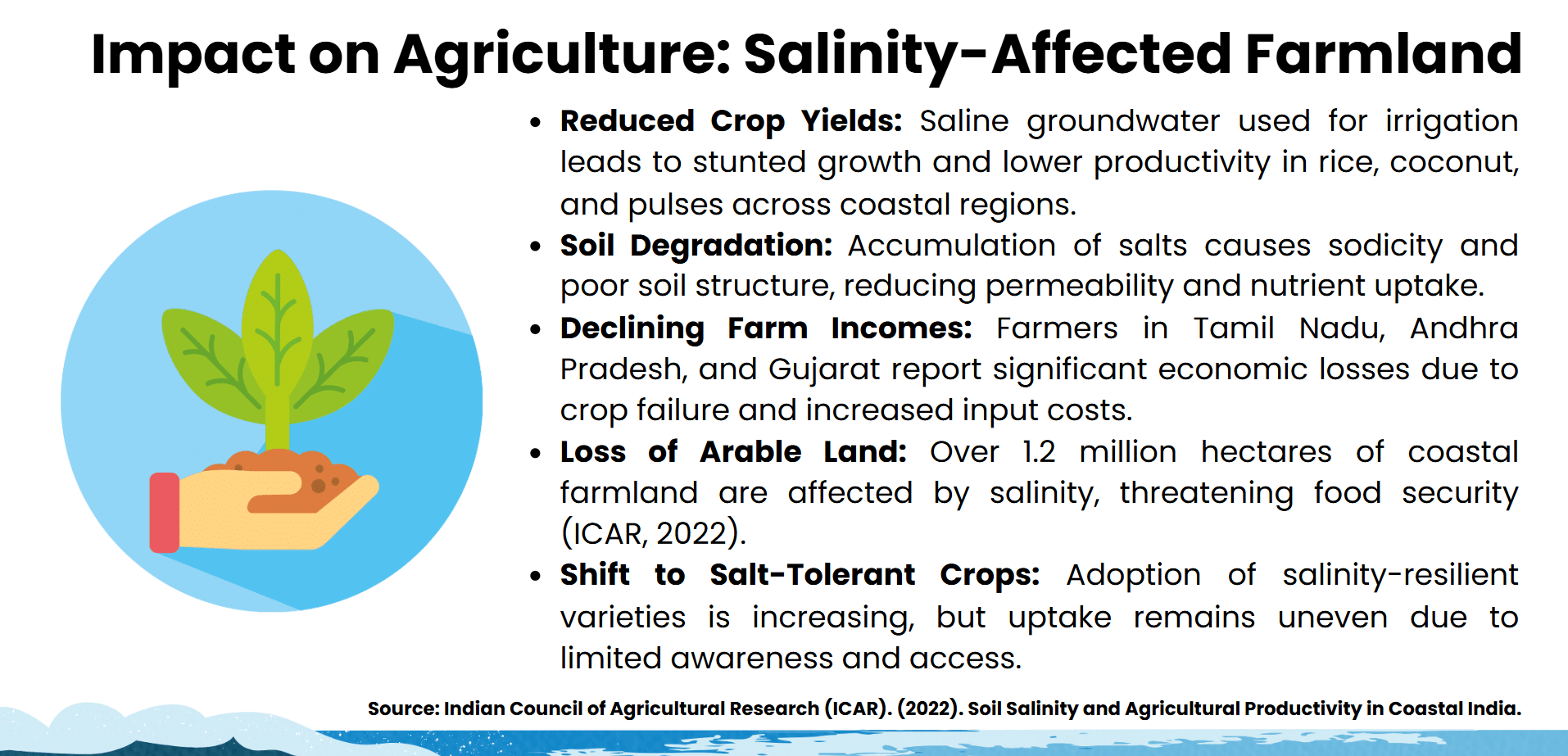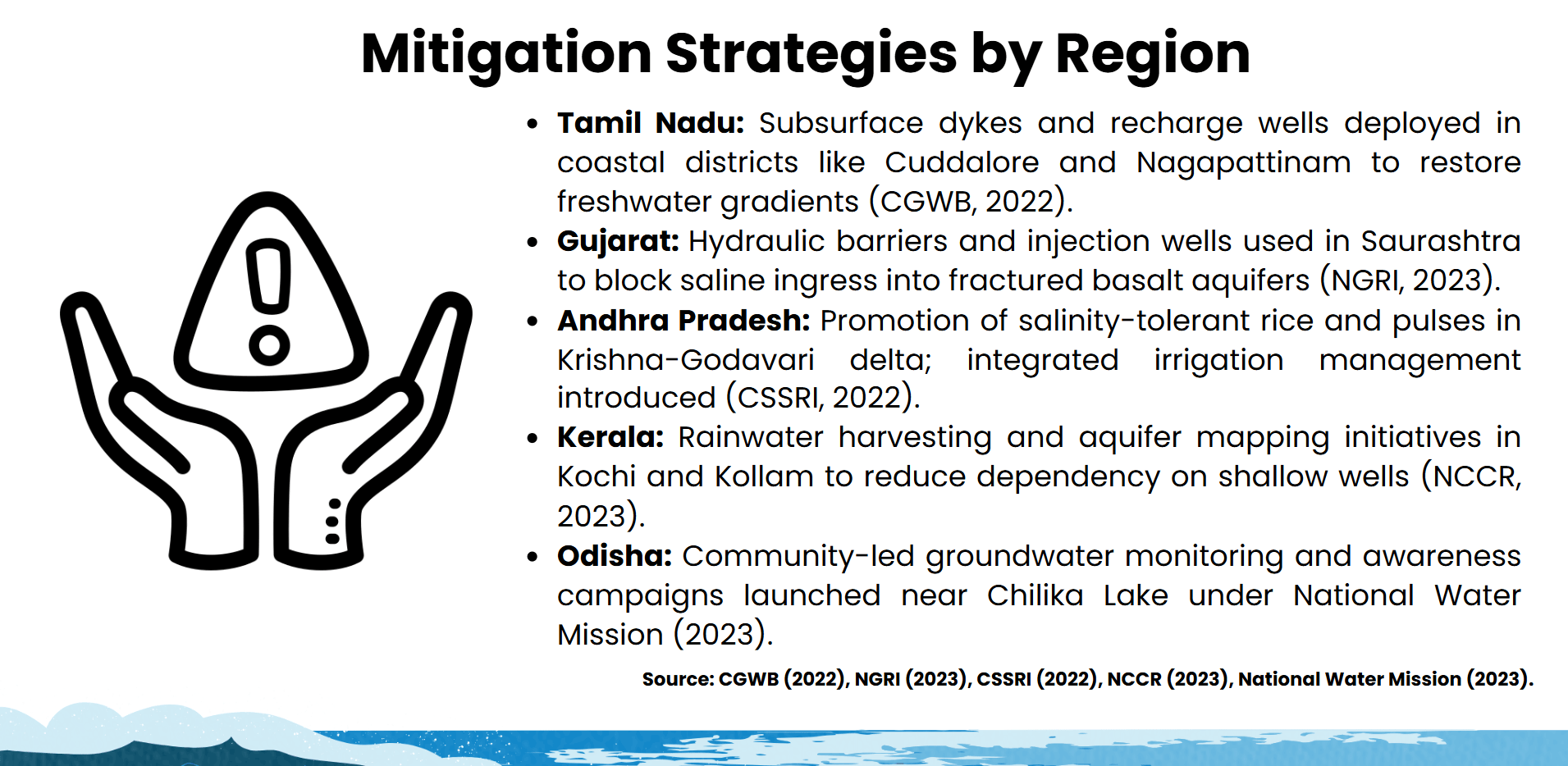The article addresses problems, effects, and mitigation of the seawater intrusion in Indian coastal aquifers, including areas of seawater intrusion intensity and use of Seawater intrusion. In India's coastal areas, the flow of saltwater into freshwater aquifers is a major groundwater problem that is mostly caused by excessive groundwater extraction and accelerated by sea level rise.

In India, seawater intrusioninto coastal aquifers is a major and increasing problem of groundwater sustainability. The country has a population density of more than 7,500 people of coastline and highly inhabited coastal aquifers that are used as a source of domestic, agricultural, and industrial water consumption. But growing anthropogenic demands-imperially, over-pumping of groundwater, uncontrolled urbanization, and land-use modifications have upset the natural hydraulic equilibrium, and salty water thus finds its way into fresh groundwater. This is compounded further by climatic mechanisms like sea-level rise and the alteration in rainfall patterns, which further increase the susceptibility of coastal geo-hydrological systems.The effects of seawater intrusion are varied, including poor water quality and declining agricultural performance, to poor outcomes in the realms of human health and ecological pressure. Nevertheless, the problem is under-addressed in the sphere of mainstream water governance and policy frameworks. The article is a critical assessment of the causes, spatial patterns, and socio-environmental consequences of seawater intrusion in the coastal aquifers of India. It also considers the existing monitoring strategies and recommendations on integrating mitigation strategies, the importance of sustainable management of groundwater, community participation, and science-policy.
Reasons for Seawater Intrusion in Coastal Aquifers in India
Seawater intrusion into the coastal aquifer is a complex of various hydrogeological, anthropogenic, and climatic contributions. In India, these strains are increasing at a mushrooming pace in social and financial upheavals and strain on the environment.
Over-Extraction of groundwater
The removal of too much groundwater via agriculture, industry, and urban water usage generates an imbalance between the fresh and saline boundaries. As the freshwater hydraulic head reduces below the sea level, saline water moves intothe land along permeable aquifers. This situation especially happens in coastal areas of Tamil Nadu and Gujarat, where population and irrigation requirements are intense (CGWB, 2021).
Urbanization and change in land use
Uncontrolled urban growth distorts recharge areas and diminishes infiltration of natural water. Concrete and asphalt surfaces do not permit percolation; most construction activity makes a mess of aquifer geometry. Moreover, the increase in the number of borewells in the peri-urban coastal belts escalates the stress of the aquifer, promoting saline intrusion by vertical and lateral flows.
Sea-Level Rise and Climate Variability
An added pressure to coastal aquifers is the heightened water levels due to global warming. Heat expansion of the oceans and melting glaciers contribute to enhancing the hydraulic head inland as seawater encroaches. Irregular monsoonal conditions and decreased precipitation also undermine rates of recharge, undermining the resilience of the aquifer to saltwater intrusion (IPCC, 2023).
Resources Recharge Deficient
Absence of systematic groundwater management and poor infrastructure regarding artificial recharge contribute to the vulnerability. The lack of freshwater barriers and the lack of monitoring and fragmented institutional control and prevent proactive management. In several coastal districts, recharge structures have either become dysfunctional or ill-maintained, so that the seawateris able to encroach further.
Geographic Hotspots in India

Seawater encroachment in coastal aquifers in India is not equally dispersed; this happens where hydrogeological susceptibility coincides with both man-made and climatic impact.
1. Industrial Pressure and Coastal Overdraft, Tamil Nadu
The eastern coast of Tamil Nadu, especially the Chennai and Cuddalore regions, have experienced a high percentage of seawater encroachment owing to heavy pumping in order to use groundwater sources in urban and industrial centers. The aquifers in the region, comprising sand, make it highly prone because of the low recharge rate and high population density that is high. According to reports by the National Institute of Hydrology (NIH, 2022), the encroachment of salinity has been witnessed to go as far as 10-15 km inland in some pockets.
2. Gujarat: Saline Intrusion in semi-arid Areas
Saurashtra and Kutch regions of Gujarat are acutely affected by seawater intrusion due to limited water recharge into the water table because of semi-arid conditions. Unconfined coastal aquifers in this region are poorly controlled and salty groundwater intrudes into the fractured basalt and alluvial terrain. As per the findings of the Central Ground Water Board (CGWB, 2021), Mandvi and Porbandar are the problem areas where immediate action has to be undertaken.
3. Andhra Pradesh: Deltaic Risk and Agrarian Stress
In the Krishna delta and Godavari delta, the groundwater in seawater intrusion is caused by low groundwater level because of paddy cultivation and improper canal irrigation improperness. The deltaic aquifers, constituted of fine sediments, are especially vulnerable to salinization. Remote sensing has been able to detect progressive patterns of intrusion with regard to seasonality and tidal movements.
4. Kerala: Urbanization of the Coast and Fractured Aquifers
The coastal zone is indeed densely populated, particularly around Kochi and Kollam, and intrudes on urban sprawl and fragmentation of aquifers. The lateritic and alluvial aquifer is shallow and sporadic, hence susceptible to saltwater intrusion during dry seasons and flood tides.
Effects on Society and the Environment
Seawater intrusion along its coastal aquifers poses a complex problem in India, having multisided impacts on ecological integrity, agricultural performance, and the health of the population and its socio-economic sustainability in the affected areas.
Destruction of the Environment and Biodiversity
Evidence of salinization of the freshwater ecosystem is the presence that disturbto biodiversity at the beach-line. Mangrove plantations, estuaries, floras and freshwater-dependent organisms are at risk of losing their property and physiological stress by increased salt concentration. This invasion causes changes in the nutrient cycle and decreases the resilience of the coastal wetland, which acts as a natural barrier to storm surges and erosion. The MoEFCC (2023) indicates that saline intrusion has helped reduce the native aquatic species in the Sundarbans and the Gulf of Mannar.
The decline of agriculture and the emergence of soil salinity
There is the impoverishment of agricultural livelihoods through the degradation of soil fertility and negative effects on agricultural productivity due to seawater intrusion. Irrigation with saline groundwater causes soil sodicity, which decreases the permeability level, besides nutrient imbalance. The Indian Council of Agricultural Research (ICAR, 2022) also indicates that 1.2 million hectares of coastal agricultural land are under salinity attack,which poses a threat to food security and the incomes of populations.
Health and Lack of Drinking Water
The contamination of drinking water sources with saline and brackish water is a major health hazard since such drinking water causes a lot of health complications, which include hypertension, gastrointestinal disorders, and skin ailments. Residents of coastal areas that lie below sea level tend to use shallow wells that are susceptible to infiltration. National Centre of Coastal Research (NCCR, 2023) points out thatelevated salinity on reaching potable water all over Kerala and Odisha, which states subsequently need to invest in desalination and rainwater harvesting facilities.

Monitoring and assessment techniques
An efficient seawater intrusion management strategy in the Indian coastal aquifers demands strong multidisciplinary monitoring systems with a blend of hydrogeological, geospatial, and hydrochemical analysis instruments to address intrusion to timely detection and intervention.
Groundwater Profile and Hydrogeological Surveys
Systematic hydrogeological surveys are central figures in intrusion assessment. These include the periodic observations by piezometers and observation wells of water tables, flow direction and aquifer properties. The Central Ground Water Board (CGWB, 2022) has long-term monitoring networks in vulnerable coastal districts to monitor seasonal and spatial fluctuations in salinity as well as aquifer pressure. This profiling assists in delineation of intrusion fronts and poorly recharged areas.
Subsurface mapping of geophysical techniques
Saline-water encroachment within sub-surface formation is commonly sensed by using electrical resistivity tomography (ERT), electromagnetic induction, and seismic refraction. Such non-invasive techniques spatially defined acquisitions of aquifer salinity, lithology, and hydraulic contact. ERT surveys in Gujarat and Tamil Nadu have been used to map saline plumes moving inland and, therefore, allow specific mitigation measures to be carried out. The National Geophysical Research Institute (NGRI, 2023) stresses the usefulness of multi-electrode arrays to perform high-resolution coastal aquifer imaging.
Geospatial and remote sensing Applications
Remote sensing using satellites and the geographical information system (GIS) can be used to map the changes that have taken place on a large scale or the groundwater table falling, etc. Indices like the Normalized Difference Salinity Index (NDSI) and the Land Surface Temperature (LST) are applied to provide indicators of intra-threats. Conditions with field observations help in integrating spatial datasets intopredictive modelling and early warning systems. The Indian Space Research Organisation (ISRO, 2023) also helps with mapping salinity in the coast with their Bhuvan programme.
An Analysis of Water Quality and Isotopic Tracking
Groundwater samples give credence to the seawater mixing due to chemical interpretation of the samples in terms of chloride, sodium, and electrical conductivity. Stable isotope measurement using δ¹⁸O and δ²H can, in addition, serve to differentiate between marineandmeteoric. The techniques play a very important role in the confirmation of geophysical and remote sensing results.
Mitigation and management strategies
Seawater intrusion challenges in Indian coastal aquifers require integrated, science-informed approaches that collectively utilize long-term groundwater sustainability and social-environmental resilience.

Artificial recharge and hydraulic barriers
Some of the techniques that are used to prevent artificial recharge are the use of percolation ponds, recharge shafts, as well as injection wells, which recharge the freshwater gradient to overcome the saltwater intrusion. In Gujarat and Tamil Nadu, injection and subsurface dykes are used to create a hydraulic barrier. When combined with the shape of fisheries and rainfall cycles, these interventions can substantially decrease the risks of intrusion. According to the recommendations of the Central Ground Water Board (CGWB, 2022), the hydrogeological mapping should be done at sites and then planning to undertake site-specific recharge planning.
Management of Extraction and Regulatory Controls
Unregulated groundwater pumping is another primary contribution to seawater intrusion. The greatest regulatory measures that will be vital include instating withdrawal abatements, licensing of borewells and the encouragement of conjunctive use of surface and groundwater. States on the coastline, such as Kerala and Andhra Pradesh, have also been ensuring groundwater zoning as well as a digital monitoring system to monitor the use. The Ministry of Jal Shakti (2023) promotes the idea of water management that is decentralized and focuses on an aquifer-based plan within the framework of Atal Bhujal Yojana.
Diversification in crops and Salinity-tolerant Varieties
Expanded planting of crops that have lower water use requirements and the development of hardy cropsthat favour salinity can cut down on the amount of water required during irrigation and soil erosion. CSSRI, the central research group at ICR (2022), has created salt-tolerant rice, mustard, and pulses that can rapidly adapt to the coastal ecosystems. Integration with the varieties using precisionirrigation and organic supplements increases adaptation at the farm level.
Community Participation Capacity Building
Education and engagement of local people through consciousness raising, groundwater monitoring aimed at community support and sustainability training in good water use maintain the long-term protection. The National Water Mission (2023) focuses on behavioural change and citizen science as examples of resilience in terms of groundwater resilience.
Conclusion
Sea water intrusion in coastal aquifers of India is an unsustainable complication that leads to environmental and socio-economicproblems caused by the unjustifiable use of groundwater, climatic changes, and weak hydrogeology reasons. Its effects, which include ecological deterioration and agricultural impoverishment, as well as risks to human health, speak to the importance of science-driven and coordinated responses. Surveillance methods and evaluation, such as hydrogeological surveys, geophysical mapping, and remote sensing, are important tools that aid with the prompt identification and prioritization of action plans. Practicing water recharging, regulatory policies, crop diversification, as well as community leadership is the primary mitigation measures that should restore the integrity of the aquifers and establish long-term resistance. Significantly, establishing a local wisdom combination with institutional systems and innovation of technology can create adaptive governance of water in vulnerable coastal areas. As India moves to sustainable development and water security, it must keep seawater intrusion central to its coastal resource management agenda. A multidisciplinary participatory way of doing things will be crucial in ensuring the preservation of the environment and the well-being of millions of people having their livelihoods in the coastal groundwater systems.